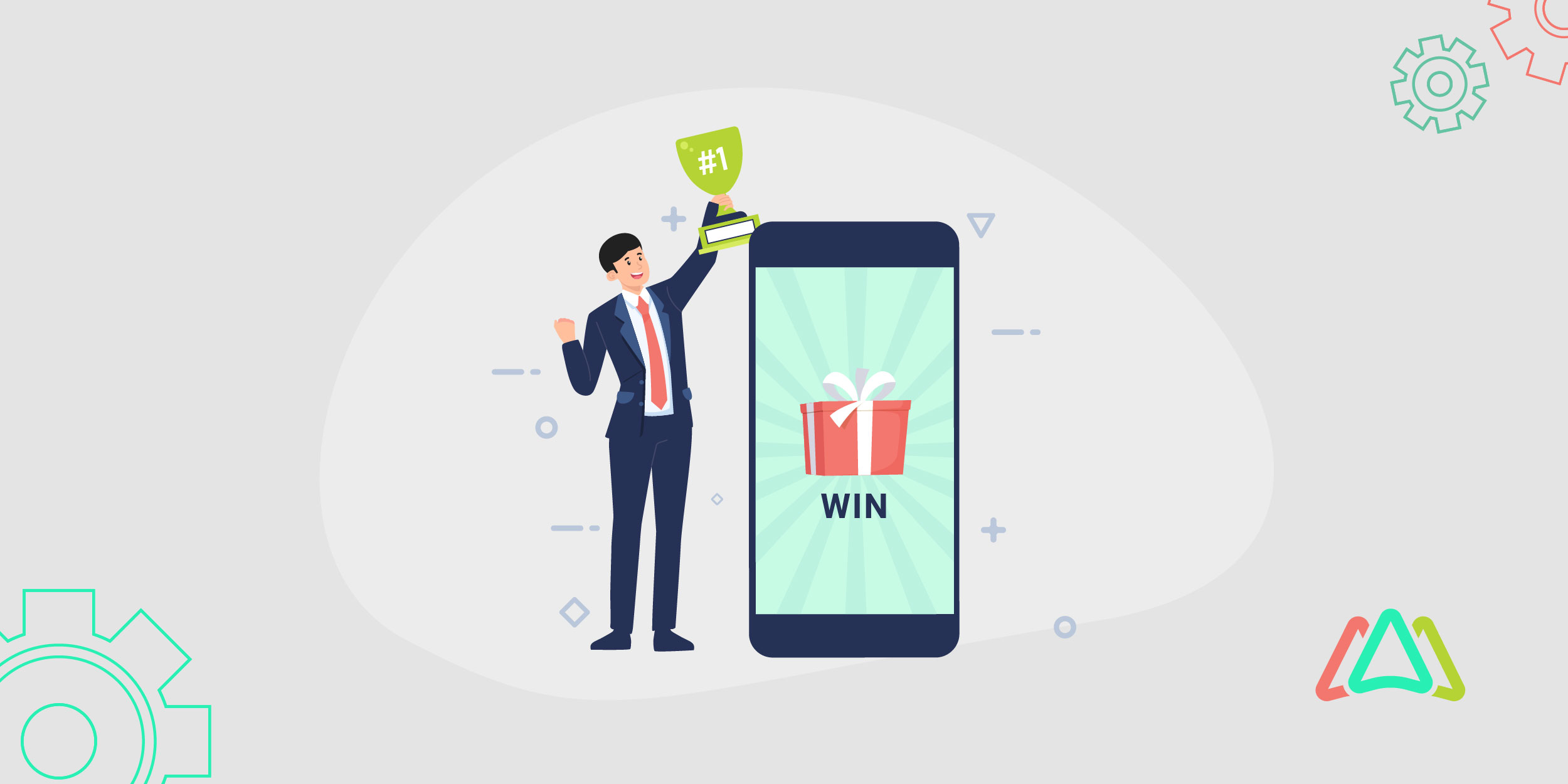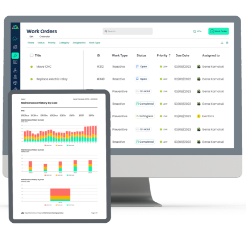
Work Order Gamification with Software
Imagine visiting a manufacturing plant where maintenance technicians gather around a large screen in their break room, watching a large screen as if they’re watching a sporting event. On the screen is a visual dashboard with the title “Leaderboard” and showing who completed the most work orders that week. These guys are competing to see who can complete the most tickets before lunch. This is the power of gamification in action.
Technicians often treat work orders like chores - repetitive, low-reward tasks that just need to be checked off. For some people, work is intrinsically exciting and motivating, but for others, it’s not that easy, and work that is repetitive is boring and not motivating. According to Ryan, R. M., & Deci, E. L. (2000), when work is not intrinsically motivating, several negative effects on productivity can occur, including: lower engagement and effort, decreased creativity and problem-solving, higher absenteeism and turnover, reduced persistence on tasks, and lower overall job satisfaction.
But what if tasks related to work order management felt more like a game? What if completing a job earned points, badges, and a spot on the leaderboard? That's the idea behind work order software gamification. Gamification is a modern approach well-suited to today's technician behavior and business performance, emphasizing workforce engagement and data-driven results. According to a recent study on gamification in the workplace the findings show that 85% of employees are more engaged and 90% are more productive when gamification is implemented in the workplace.
What Is Work Order Gamification?
Work order gamification is the integration of game-like attributes such as rewards, progressive levels, and competition into maintenance and facility management systems. Instead of passively managing tasks and work orders, assigned technicians actively engage with their work, motivated by visible progress and peer recognition.
A 2023 study by the University of Colorado found that organizations using gamified productivity tools experienced a 60% increase in task completion rates.
With work order software gamification, organizations can augment and improve technician behavior and performance relying less on ineffective methods that often feel like micromanagement. The gamification system encourages positive performance behaviors like faster response times, better data entry, and consistent task completion through the use of positive reinforcing ques; points, leaderboards, and performance dashboards.
The Psychology Behind Gamification
Gamification plays on basic human psychology, especially intrinsic motivation, recognition, and healthy competition. As people, we are naturally driven to pursue goals, build status, and earn accolades for our efforts. These elements are applied in the workplace to turn otherwise boring tasks into engaging challenges.
Take the case of Amazon's warehouse operations, where gamification was introduced to boost efficiency and engagement among employees. In UK and US warehouses, Amazon implemented voluntary games, such as "Castle Builder" and "Racer," which were displayed on large screens. As staff picked and packed items, they earned points and built virtual castles or raced digital cars, with their progress reflecting their real-world performance.
Within months, managers saw dramatic improvements in the number of tasks being completed and a much more motivated workforce as employees vied for the top on the leaderboards and earned new virtual rewards.
Gamification makes performance visible and rewarding, turning routine tasks into engaging challenges and sparking friendly competition that drives consistent improvement just by applying these psychological triggers within work orders.
Let's discuss some of the gamified elements organizations can add to their task management systems.
Gamified Elements in Work Order Software

Work order software gamification introduces features designed to make task completion more engaging and performance-driven.
Point System
The Points System is the heart of gamification. Technicians earn points for completing a work order based on factors such as speed, accuracy, task priority, and safety compliance. This makes performance quantifiable in real-time, providing technicians with instant feedback.
Leaderboards
Leaderboards highlight top performers, sparking friendly competition between teams. Either posted on a digital dashboard or a breakroom screen, leaderboards provide visibility and status, and encourage others to improve.
Achievement Badges
Achievement Badges reward milestones, such as completing the 100th work order or going a whole month without any overdue tasks. These digital trophies reinforce consistency and celebrate long-term effort.
Dashboards
Performance Dashboards employ KPIs and performance data and visualize them using visual graphics like gauges, progress bars, rings, or levels to quantify productivity clearly. Technicians don't just see numbers; they see their performance visually and in progress.
Missions
Daily and Weekly Missions keep things fresh with short-term challenges. For example, a mission might be to complete five urgent tasks by noon. These mini-goals or sprints create urgency and purpose. Kinda like those daily quests in video games that keep you coming back for more.
Feedback
Lastly, Feedback facilitates rapid understanding through immediate feedback (e.g., notifications) or bonuses (e.g., extra points), motivating technicians to meet deadlines.
Combined, these features transform routine maintenance into a performance-driven application, where technicians are more engaged and operations run more effectively.
Benefits of Gamifying Work Orders
Boost Technician Engagement
Gamification offers instant recognition for the work that technicians do. Points, leaderboards, and achievement badges make their contributions visible, helping them feel recognized and become more invested in their work.
Improve SLA Compliance
Assigning higher point values to urgent or high-priority tasks in gamified systems naturally encourages technicians to respond faster, reducing delays and improving Service Level Agreement (SLA) compliance.
Increased Productivity
By implementing gamification within work order management software, organizations can significantly enhance the productivity and engagement of their technicians. This approach leverages inherent human motivations through carefully designed reward systems that incentivize efficient task completion. These systems can range from simple digital badges awarded for achieving milestones or adhering to best practices to more competitive elements like real-time leaderboards that foster a sense of healthy rivalry among team members. The immediate feedback and recognition provided by these incentives cultivate a sense of urgency and purpose, directly translating into a higher volume of completed work orders and a reduction in turnaround times. Furthermore, gamification can contribute to a more positive and engaging work environment, leading to increased job satisfaction and reduced employee turnover. The strategic integration of game-like mechanics can transform routine tasks into engaging challenges, ultimately driving improved operational efficiency and overall business performance.
Encourage Continuous Improvement

Through friendly competition, technicians are constantly pushed to improve. When performance is tracked and visible, team members are motivated not only to meet standards but also to exceed them, developing a culture of ongoing growth.
Improve Data Accuracy
When points or rewards are tied to complete and accurate work order entries, technicians become more careful and consistent with their inputs. This results in better-quality data for analysis and decision-making.
However, not all work order software is built equally, especially when it comes to gamification.
Let's talk about choosing the right work order software that best gamifies your organization's workflow.
Choosing the Right Work Order Software with Gamification
It's essential to choose a platform that offers the right mix of functionality and flexibility.
Reward Tracking Features
Goal-setting and reward tracking features are also essential. The software should let you define specific missions on a daily, weekly, or monthly basis and track technician progress with built-in incentives, such as badges or point multipliers.
Leaderboards
Leaderboards drive behaviour; they are a central part of gamified systems, but they must be thoughtfully designed. Look for software that allows customizable leaderboards based on meaningful metrics, not just the quantity of tasks completed. You should be able to rank technicians based on quality scores, safety compliance, response times, or a weighted combination of these factors. Also consider team-based leaderboards, which promote collaboration over individual rivalry. The ability to reset leaderboards periodically (daily, weekly, monthly) can keep the experience fresh and give everyone a fair shot at recognition over time.
User Experience
The gamified experience becomes tangible through a visual and intuitive dashboard. For example, progress bars, achievement rings, and visual indicators of mission completion are a great way to drive user adoption or immediate daily motivation.
Integration
Seamless integration with your CMMS or mobile work order app is another must-have. Technicians need to interact with the gamified system as part of their daily work, whether they are in the field or at a workstation.
Future of Gamified Maintenance Operations
The future of gamified maintenance operations will be significantly shaped by the deep integration of artificial intelligence, moving beyond simple point systems and badges to create truly personalized and dynamic experiences for maintenance technicians. This next evolution will see AI acting as an intelligent guide, continuously learning and adapting to the unique strengths, weaknesses, and working styles of each individual. Imagine a system that understands John’s mastery of HVAC systems through his historical work order data, successful resolution rates, and even the types of technical documentation he frequently consults. Conversely, the same AI might identify areas where John could benefit from further development, such as electrical troubleshooting, perhaps indicated by longer resolution times, repeated errors on similar tasks, or fewer completed electrical work orders.
The gamified system will dynamically generate and tailor missions, challenges, and learning opportunities. For John, this might mean receiving complex HVAC-related tasks that stretch his expertise and earn him significant rewards upon successful completion. Simultaneously, the system might subtly introduce smaller, more focused electrical tasks, perhaps framed as collaborative challenges with a more experienced colleague or linked to readily accessible training modules. This personalized approach ensures continuous growth and skill diversification, preventing stagnation and fostering a more well-rounded and adaptable workforce.
Artificial intelligence will revolutionize how technician performance is monitored and improved through sophisticated, real-time performance analytics. By continuously tracking a wide array of metrics – including task completion times, first-time fix rates, adherence to safety protocols, diagnostic accuracy, and even the quality of work order documentation – the AI will identify intricate patterns and correlations that would be impossible for human managers to discern manually. This constant analysis will provide a rich, data-driven understanding of individual and team performance, highlighting areas of excellence and pinpointing specific skills gaps or process inefficiencies.
This wealth of information will enable the gamified system to function as an innovative and highly effective coaching tool. Instead of generic performance reviews, technicians will receive personalized feedback, precisely targeted recommendations for improvement, and achievable goals aligned with their individual development needs. For instance, if the AI detects a pattern of slightly longer completion times for a particular type of equipment repair, it might offer a micro-learning module on advanced troubleshooting techniques for that specific asset, followed by a gamified challenge to apply those new skills in a real-world scenario. Recognition will also become more nuanced and impactful. Beyond simple points, the system could award specialized badges for demonstrating mastery in specific areas, publicly acknowledge significant contributions to team success, or even unlock access to advanced training resources based on consistently high performance. This continuous cycle of analysis, personalized feedback, targeted development, and relevant recognition will create a highly engaging and motivating environment that drives continuous improvement. The "pretty cool" aspect is the seamless integration of performance management with an engaging gamified framework, transforming what can often be a tedious process into an enjoyable and rewarding experience.
Predictive Gamification: Incentivizing Proactive Maintenance
Moving beyond reactive maintenance models, Predictive Gamification will leverage the power of historical asset data, sensor readings from IoT devices, and advanced analytics to anticipate potential equipment failures. The gamified system will translate these predictive insights into proactive missions for technicians, incentivizing them to take preventative actions before breakdowns occur. Imagine a scenario where the system identifies an aging pump that has exhibited a pattern of increased vibration and elevated temperature readings, indicating an impending failure. Instead of waiting for the pump to fail and disrupt operations, the system might issue a proactive "Predictive Maintenance Mission" to a technician with the necessary skills. This mission could involve performing specific diagnostic tests, lubricating critical components, or even replacing a worn part identified by predictive analytics.
To further enhance engagement, the system will award bonus points, special badges, or even entries into team-based leaderboards for successfully completing these proactive tasks and preventing potential downtime. This creates a powerful incentive structure that aligns technician efforts with organizational goals of maximizing uptime and minimizing costly emergency repairs. It’s no longer just about fixing what’s broken; Predictive Gamification transforms maintenance into a proactive and strategic function, where technicians are rewarded for their foresight and their ability to avert problems before they even "arise!" This shift not only improves asset reliability but also fosters a sense of ownership and proactive problem-solving among the maintenance team. For smaller organizations, the use of small business work order software integrated with AI-driven gamification can make predictive maintenance affordable, accessible, and scalable without requiring enterprise-level budgets.
Collaboration will be a key element of the future of gamified maintenance, moving beyond individual achievements to foster a stronger sense of teamwork and shared responsibility. Cross-team tournaments will allow companies to establish engaging performance leagues where different maintenance teams can compete against each other on a variety of critical metrics. These metrics could include Service Level Agreement (SLA) compliance rates, overall downtime reduction percentages, adherence to safety protocols, the efficiency of resource utilization, or even customer satisfaction scores related to maintenance services.
Think of maintenance departments engaging in friendly but competitive "quasi-fantasy football leagues," but instead of drafting players, teams will be composed of their actual technicians, and the "scores" will be based on their real-world performance against key operational indicators. These tournaments can be structured over various timeframes (weekly, monthly, quarterly) and can involve different types of challenges and scoring systems to maintain engagement and cater to different team strengths. For example, one week might focus on rapid response times, while another could emphasize first-time fix rates or the completion of preventative maintenance tasks. Leaderboards will provide real-time visibility into team standings, fostering a sense of healthy competition and encouraging teams to collaborate, share best practices, and support each other to achieve collective success. This competitive yet collaborative environment will not only drive performance improvements across the entire maintenance organization but also foster stronger inter-departmental relationships and a shared commitment to achieving key business objectives, with a tangible and meaningful "real-world impact."
Conclusion
Work order software evolution is more than just a technological upgrade; it marks a fundamental transformation in maintenance management. Over the years, these systems have shifted from basic ticketing tools into intelligent platforms that streamline operations, integrate with IoT, harness AI for predictive insights, and support mobile-first, cloud-based workflows. This progression has redefined how organizations approach asset management and maintenance planning.
The benefits are undeniable: evolving platforms deliver greater efficiency, transparency, and adaptability while aligning with strategic business objectives like cost reduction, compliance, and scalability. Most importantly, this evolution reflects what’s achievable right now. The right work order software doesn’t just manage tasks—it adapts, learns, and grows with your organization. Ask yourself: does your current system simply record work, or does it actively help you stay ahead of challenges? If it’s the former, embracing the next stage in the work order software evolution could dramatically reshape both your maintenance strategy and long-term outcomes. Your entire operation will feel the difference.
TABLE OF CONTENTS
Keep Reading
Every maintenance professional faces it sooner or later — that critical time when an aging ...
18 Nov 2025
The term 'best' is often used loosely, without a clear understanding of its context or ...
14 Nov 2025
In the not too distant past, maintenance strategies have been defined by reaction—fixing ...
13 Nov 2025
Tax season is the time of year that often sends a ripple of anxiety through many of us. The ...
11 Nov 2025
Selecting a Computerized Maintenance Management System (CMMS) can, at first glance, be an ...
4 Nov 2025
In healthcare facilities, equipment uptime involves more than achieving operational ...
31 Oct 2025
Companies are subject to economic ups and downs, also known as economic volatility. Today, ...
30 Oct 2025
Maintenance challenges are a constant struggle, with unplanned downtime costing manufacturers ...
27 Oct 2025
Last winter, a maintenance technician at a U.S. paper mill ignored a predictive alert that ...
10 Oct 2025
Many organizations proudly say they “have a CMMS,” but ownership alone doesn’t equal ...
9 Oct 2025
Every maintenance team is under pressure to do more with less. Unplanned downtime is often ...
7 Oct 2025
The implementation of simple, yet powerfully effective, checklists has repeatedly ...
3 Oct 2025
In manufacturing, every second counts. When production stops, whether due to scheduled ...
2 Oct 2025
The increasing cost of maintenance, lack of accountability, and siloed systems leave many ...
30 Sep 2025
Preventive maintenance is one of those things maintenance teams know they need to do, but it ...
26 Sep 2025
Public services are essential to daily life. The provision of safe roads, functional transit, ...
25 Sep 2025
For most manufacturing facilities, a major focus of their maintenance teams revolves around ...
24 Sep 2025
Have you ever tried explaining to the CEO why the production line has been down for hours ...
18 Sep 2025
Over the past few decades, the hotel industry has undergone a dramatic transformation. ...
16 Sep 2025
Profitability is at the top of the list for manufacturing organizations when conversations ...
12 Sep 2025





